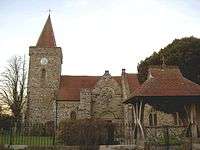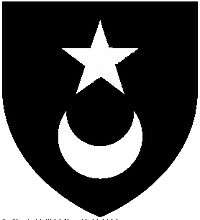Filleigh

Filleigh /faɪliː/ is a small village, civil parish and former manor in North Devon, on the southern edge of Exmoor, 3 1/2 miles west of South Molton. The village centre's street was, until the 1980s opening of the North Devon Link Road, the main highway between the North Devon administrative centre of Barnstaple and South Molton, leading westwards to Taunton. Much of the village's land is contained within grade I listed park and garden, Castle Hill, which straddles both sides of the Link Road providing a glimpse of some of it.
History
Manor
De Filleigh
The manor was held in the 14th century by a family which took its name from the manor, de Filleigh. The family also held lands within the neighbouring settlements of East Buckland, Bray and Charles.[1]
Denzell

On default of male heirs, the manor passed by marriage to the Denzell (or Densyll etc.) family. This family originated from Denzell manor in St Mawgan parish, near St Columb Major, near Newquay, Cornwall.[2] The senior line became extinct in the male line on the death of John Denzel (died 1535), sergeant-at-law and Attorney-General to the Queen Consort, Elizabeth of York. He held large estates in Cornwall and left two daughters as his co-heiresses, Ann who married Sir William Holles (1509–1591), later Lord Mayor of London, and another daughter who married into the Roskymer family. It was a cadet branch of this family which had acquired the de Filleigh lands by marriage. The arms of Denzell were: Sable, a mullet in chief and a crescent in base argent.[3] These arms can be seen sculpted on a bench-end, c. 1510, in Weare Giffard Church, where exist others adorned with Fortescue arms and those of other heiresses who brought possessions to the Fortescue family. The Denzell arms are also shown in the second quarter of the arms of Richard Fortescue (died 1570) on his monumental brasses in Filleigh Church.
Fortescue
In 1454 Sir Martin Fortescue (died 1472), second son of Sir John Fortescue (1395–1485), Chief Justice, of Ebrington Manor in Gloucestershire, married Elizabeth Densyll (d.1508),[4] a daughter and co-heiress of Richard Densyll of Filleigh, and thereby the manor became a possession of the Fortescue family, together with substantial other Densyll manors including Weare Giffard, Buckland Filleigh, Combe and Tamerton. Elizabeth Denzell survived her first husband and remarried to Sir Richard de Pomeroy (1442–1496), KB, feudal baron of Berry Pomeroy, Devon, Sheriff of Devon in 1473. The Easter Sepulchre monument to Sir Richard Pomeroy and Elizabeth Denzell survives in Berry Pomeroy Church, with sculpted armorials, but is missing all its original monumental brasses, robbed before 1701, as described by the biographer Rev. John Prince (1643–1723), for many years vicar of Berry Pomeroy:[5] "As for any monuments raised over the graves or sepulchres of the dead relating to this family there is only one remaining, now robbed of its former splendour. It is an altar-tomb under an arch in the north wall of the chancel raised near breast-high covered with a fair table of green marble which was sometime inlay'd with a coat of arms and a motto under of gilded brass or copper. On a rough marble stone about six-foot long and three deep fastened in the wall over the tomb and under the canopy were inlaid in like manner the effigies of four several persons in large proportion with labels proceeding out of their mouths. Also four smaller figures between as many escotcheons, (sic) all of gilded brass or copper. Which are long since become the prey of some greedy or childish hand. At the east end of this monument is Pomerai impailed with Denzil, at the west end single, which shew it was raised to the memory of Sir Richard Pomeroy and his lady, who was the daughter and heir of Denzil. The arch is finely fretted and flowered". The arms of Denzell A mullet in chief and a crescent in base impaled by Pomeroy, are sculpted in stone, but without any tinctures or colouring, under the east end of the arched alcove containing this monument and provide valuable confirmation of the form of the Denzell arms.
The Filleigh Estate, comprising 5,500 acres (22 km2), together with Castle Hill mansion are still today privately owned by descendants of the Fortescue family.
Church of St Paul
Old Church
The old mediaeval church was demolished by Lord Clinton in about 1730, as being situated adjacent to the old manor house which was to be re-modelled into the Palladian mansion, it interfered with the ambitious related landscaping plans. The only surviving fabric from the old church comprises the two monumental brasses which formerly adorned the now lost tomb-monument of Richard Fortescue (died 1570), great-grandson of Sir Martin Fortescue. These brasses, in damaged and incomplete condition perhaps indicating their having been carelessly wrenched off the former monument, are now framed and affixed to the north wall of the nave of the new church.
New Church
The present parish church of St Paul was built in 1732 on a new site 1/2-mile west of the new Palladian mansion of Castle Hill which was then being built by Lord Clinton.[6] It was designed to be an "eye-catcher", visible from the terrace of Castle Hill. It was re-modelled in 1876-7 to the plans of Clark of Newmarket, Gilbert Scott having been consulted on the plan in 1864, in a neo-Norman style, and resulted in the addition of a south aisle, now the "Fortescue Chapel", and chancel in the form of an apse. The Fortescue Chapel contains several mural monuments to members of that family.
Fortescue monuments
Monument to Lucy Fortescue (died 1767)
On the west wall of the south aisle chapel is a mural monument inscribed thus:
"To the memory of Lucy Fortescue daughter of Matthew Ford Aylmer of the Kingdom of Ireland and widow of Hugh Fortescue of Filleigh in the county of Devon, Esq. She retired for the latter part of her life to her jointure house at Ebrington in Gloucestershire where she passed her time in the continual exercise of all the social virtues which can enoble a private life: Hospitality, Charity, Unbounded Benevolence; and died as she had lived with calm resignation and humble but confident hopes in the mercy of God through Jesus Christ her Redeemer; on the seventeenth day of February 1767 and in the 80th year of her age. To his most dear and most honoured parent, Matthew Lord Fortescue raised this stone".
Castle Hill mansion

Castle Hill is a privately owned Palladian country house built in 1730 by Hugh Fortescue, 14th Baron Clinton (1696–1751), who was created in 1751 Baron Fortescue of Castle Hill and Earl of Clinton.[7] The house is occasionally opened to the public, whilst its surrounding garden and parklands are open to public access during spring and summer months. The Castle Hill estate borders the village.
Park
Much of the land is included in the estate, as mentioned, covering a substantial area. Its grade I status in terms of landscape is due to its diversity. Included are a series of ornamental drives through garden and woodland, mature and replanted woodland as well as follies, some of impressive façade size.[8]
Railway
In 1873, the Devon and Somerset Railway opened a line from Taunton to Barnstaple, including a station at Filleigh. This became part of the Great Western Railway in 1901, and closed in 1966.
Lynmouth Flood
Storms and severe flooding in August 1952 lead to the Lynmouth Flood Disaster At the same time, three Scouts were lost while camping beside the River Bray close to the village.
External links
![]() Media related to Filleigh at Wikimedia Commons
Media related to Filleigh at Wikimedia Commons
References
- ↑ Lauder, Rosemary, Devon Families, Tiverton, 2002, p.77
- ↑ Lysons, Daniel & Samuel, Magna Britannia, Cornwall, Vol.3, 1814, Parishes: Maker – Merther, pp.212–227
- ↑ Lysons, Daniel & Samuel, Magna Britannia, General history: Extinct gentry families, Vol.3, Cornwall, 1814, pp. 118
- ↑ Vivian, Lt.Col. J.L., (Ed.) The Visitations of the County of Devon: Comprising the Heralds' Visitations of 1531, 1564 & 1620, Exeter, 1895, pp.605–9, Pomeroy
- ↑ Prince, p.648
- ↑ Cherry, B & Pevsner, N., The Buildings of England: Devon, London, 2004, Filleigh, p.449
- ↑ Debrett's Peerage, 1968, p.462
- ↑ Historic England. "Details from listed building database (1000120)". National Heritage List for England.
Coordinates: 51°02′06″N 3°54′36″W / 51.03500°N 3.91000°W
